PGA Tour Clubhead Lag Part 2
- by Kelvin Miyahira
As we have seen in Part 1 of this series on clubhead lag, the PGA tour players vary widely in their use or non-use of lag. Some retain a lot of lag while some lose it very early. This could possibly be attributed to instructional disagreements where some swing philosophies believe in the notion of lag whereas some are afraid of it (and should be). Some swing philosophies have such a superficial understanding of lag that some of the very ideas themselves cause a loss of lag. But the bottom line for most average golfers is that they lose it way too early and this ultimately results in a cast, flip, loss of clubhead speed, excessive spin, fat shots and a host of other related errors. Thus, if you wish to increase your driving distance and ability to compress the ball to hit irons longer, pay some attention to the many micro moves involved and you should see a difference in your ballstriking ability.
Lag Micro Move #1 – Radial Deviation
Perhaps the most basic of all the lag moves is radial deviation. This is the simple act of bending your wrists so that your wrist is bent toward your thumb. This increases the lag.
Here’s Tommy Gainey, one of the leaders on the PGA tour in lag showing his move to increase radial deviation in transition.
This is pretty easy to understand but is just a small percentage of the total picture of what’s involved in lag. So let’s delve into the more unobvious parts of lag.
Lag Micro Move #2 – Left arm Extension
How does this relate to the golf swing? In order to get the downswing started, the golfer needs to start to apply a force to help hold the lag since, without it, the club would start releasing immediately. The left arm straightening is applying that force that.
So here’s Stuart Appleby lengthening his left arm. Notice that his left arm goes from slightly bent in the backswing and straightens during transition.
Just in case this is not enough proof, Jamie Sadlowski, who made the cut in his first Nationwide Tour event, shows a similar left arm straightening in transition.
Note: This left arm straightening is not to be confused with both arms straightening or extending.
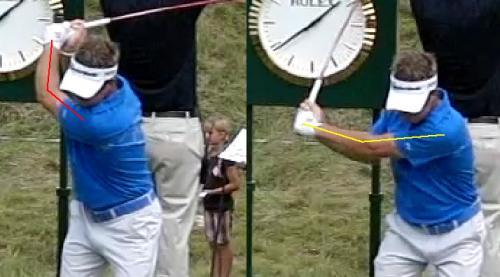
And we go from the longest hitter on the planet to the shortest on the PGA tour, Brian Gay. Clearly there’s not a lot of lengthening of the left arm. But his right arm is extending. Is that good?
Lag Micro Move #3 – Right Shoulder External Rotation
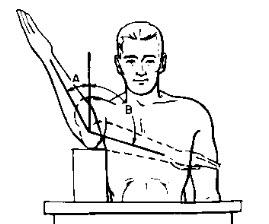
Not to be confused with turning one’s shoulders, external rotation of the shoulder is shown by movement “A” in this picture. Movement “B” is depicting internal rotation of the shoulder.
This is part of what I previously called the “elbow move” that Alvaro Quiros does very well. Notice how fast the elbow pulls forward while the hands are held back. This shows that the right shoulder is externally rotating while the transverse adduction is also taking place (micro move to be discussed next).
What is important about this move is that the external rotation of the right shoulder is primarily responsible for “dropping into the slot” or flattening your downswing plane.
Of course, you can do this incorrectly. If you pull the right arm forward while internally rotating the right shoulder, this is what it looks like...
This explains why Brian’s right arm gets stuck behind. The muscle mechanics involved are pretty simple. By internally rotating his right shoulder, he is using this powerful move way early in the downswing. But once he uses this move, he cannot continue to use it. It will eventually run out of range of motion. Then the only available motion to the right arm will be to extend it early (which he does) but in golf lingo isn’t that what we call a cast or early release? Yup.
What’s also important to know is that the most extreme laggers on tour hold this right shoulder external rotation all the way until milliseconds before impact!
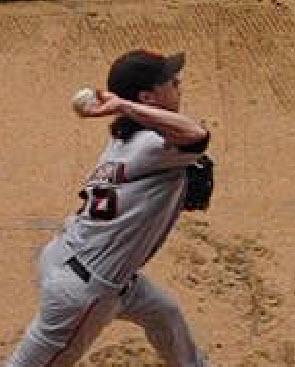
Here’s baseball pitching legend in his own time pitcher Tim Lincecum showing how late he holds external rotation of his right shoulder. This is where the external rotation of his right shoulder is at its max.
Six frames at 210 fps (shot with Casio EX-FH20) prior to release is when his arm reaches maximum external rotation then begins to “release” to internal rotation. Thus, 6 x .0048 = .029 seconds or 29 milliseconds prior to release point is when he starts to rotate his arm internally.
Given that high performing golfers should be able to use their bodies similarly, let’s see how this time frame matches up.
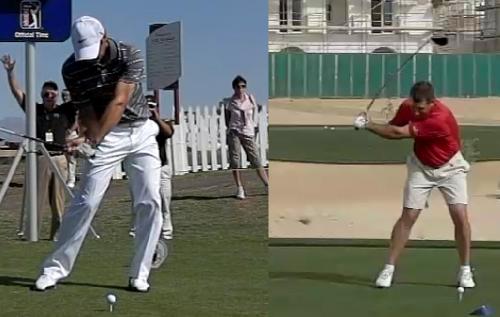
So here’s Trevor Immelman on the left with Lee Westwood on the right. This is where maximum external rotation of the right shoulder is for both players.
Now watch the animation to see how the right arm (humerus or upper arm bone) rotates while the hands are pulled forward. That shows the internal rotation of the shoulder. It also straightens while it is rotating internally.
Trevor’s right shoulder reaches max external rotation 10 frames prior to contact at 300 fps (using Casio EX-F1). Thus it fires 33 milliseconds prior to contact. That would seem pretty much in line with Tim Lincecum’s max external rotation of his right shoulder in the pitching motion.
On the other hand, Westwood’s internal rotation started 25 frames or 83 milliseconds prior to contact. That’s almost 2.5 times as early. Thus from a human performance standpoint, it’s way too early and will create his max speed way early and also results in flip that adds spin and loft therefore a loss of distance. Perhaps that’s why he has to be so huge???
Better Late Than Never
Here’s Carl Pettersen with his unusual move. He internally rotates his right shoulder (over the top move) but then recovers with a late external rotation of the shoulder. This changes the club/arm position from one that is very steep to one that is “on plane” by most people’s standards.
Lag Micro Move #4 – Right Arm Pulls Forward (Transverse Adduction)
This move must be combined with the previous move of external rotation.

Transverse adduction is best described when performing this pec deck exercise. With the back of the arm down, the right arm is pulled to the center of your body.
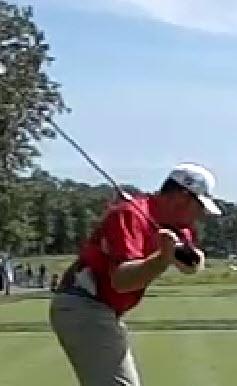
Incorrect Variation – Right Arm Pulls Back and Down (Adduction in the Coronal Plane)
Do not confuse transverse (horizontal) adduction with adduction in the coronal plane (arm is moving vertically down toward his side). If the right arm is adducting in the coronal plane, it will typically get stuck behind the right hip and be forced into flipping. Compare JB with Rickie below.
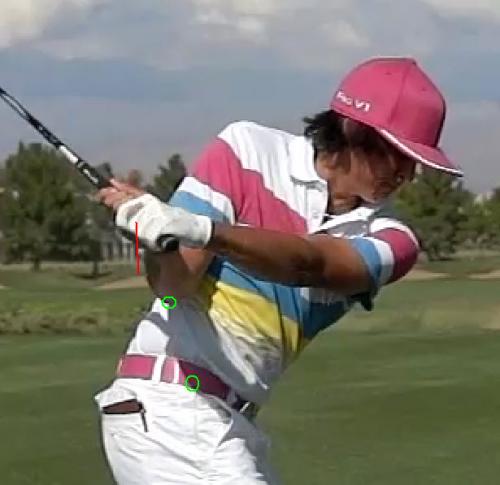
Rickie may have great lateral bend but his right arm moved straight down instead of forward.
Note: For some people with massive over the top moves, the image of Rickie’s hand movements can be helpful.
Lag Micro Move #5 – Right Bicep Contraction
This is more related to a fascial connection (check out Thomas Myers Anatomy Trains for more info) between the scapula movements governed by the pectorals and latissimus muscles. As the right scapula retracts and digs into the chest, the right bicep will contract as well and appear to narrow the “L” of the right arm into more of a “V.” See if you can see this in Sergio’s swing above.
Meanwhile in Opposite World...
http://www.youtube.com/watch?v=FfOpZkD1Mjk
Here’s Mr. Stack and Tilt Mike Bennett showing how to extend your right arm early. If you’ll watch carefully, you can even see a move to internally rotate his right shoulder at the start of the downswing.
Some Physics
The first five micro moves are really the cornerstone of what lag is all about or what physicists like Dave Tutelman calls “negative torque.” The left arm straightening and “tucking” of the right elbow by using external rotation of the shoulder, transverse adduction and right bicep contraction will “retard the release and hold lag” according to Tutelman.
In what looks like a contradictory way, negative torque creates forces to restrain the forward movement of the club while some of the other micro moves will aid in bringing the arms closer to the body to decrease the moment of inertia to allow the body to develop more rotational speed. Only within the last 30 milliseconds they release the stored up energy in their shoulders, arms, forearms and wrists to produce maximum clubhead speed as close to impact as possible. For more information about physics and golf go to Dave’s website at http://www.tutelman.com/golf/swing/handhit.php
The Yin and Yang of Golf
Performing the first five micro moves is somewhat simple though many amateurs apply positive torque early (create a cast or early release) and cannot even get this part of the swing correct. Or many amateurs can make great practice swings but then when over the ball they swing more like Freddy Kreuger hacking away at that little white ball. Why?
Holding lag while generating body rotation requires a huge amount of energy and muscle force in opposite directions! In other words, in order to hold lag for as long as the best laggers on tour do, you’re somewhat hitting the gas and brakes at the same time, then at the very end letting go of the brakes.
Logic tells you that in order to hit that ball far, you must fire all muscle force in the same direction. For right handers, this means we’d think we would want all the muscle force directed in the counterclockwise direction toward the ball. Au contraire!
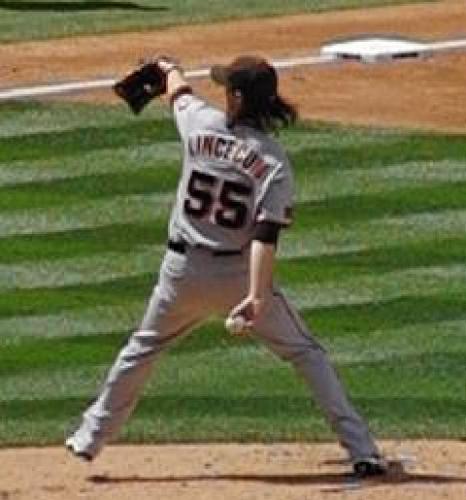

In Lincecum’s motion, his right glute fires to “hold” external rotation of the hip while the left glute fires to externally rotate. This is the same as the Sam Snead or Jamie Sadlowski’s squat move.
This reminds me of a teenage kid the other day that was showing off to his friends how brilliant he is. While at the stop light in front of me, he decides to press his brakes and gas at the same time. The result? Something like this.
http://www.youtube.com/watch?v=5m5DaYLwgbk
The purpose of firing both glutes is so that they can fire the left hip and create rotation while holding the right glute so that it creates a huge stretch and therefore even more rotation during a second firing. We have seen what firing both hips at the same time leads to... a stall.

While all of this is going on in the lower body, the left side of his body is moving counterclockwise while his right side is pulling clockwise. Look at the letters of his name. He’s lost two letters. Looks like “Lincum.” This is exactly what is going on in great golf swings. Let’s see how the body works with the next three micro moves.
Lag Micro Move #6 – Left Scapula Increase Protraction
From this elevated view we can see Dustin Johnson’s spine rotating away from his left arm thus increasing left shoulder protraction. DJ’s serratus anterior or boxer’s muscles fire to create the left scapula protraction and are helping to extend the left arm as well.
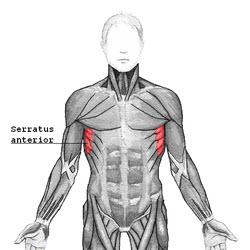
Serratus anterior on the left side is mainly responsible for the left shoulder protraction.
From front view, you cannot see the separation so easily but you can see that the stretch in the back of the left shoulder is retained.

Brian does not seem to have this left shoulder increasing protraction. Perhaps this is due to an early left shoulder retraction and right shoulder protraction? It is the logical move to fire all muscles in one direction but...
Try this yourself
Put your left arm in DJ’s position. Try to keep the left arm held back and increase the bend in your wrists while rotating your lower body. You will feel the stored energy building in your torso through your left lats that goes all the way to your left arm and wrist.
Next, try allowing the left scapula to retract (pull shoulder back) and extend your right arm just the slightest bit. You should feel most of that stored energy disappear and even your wrist angle will lose its lag angle!
Could this explain why Jamie retains more of his lag at left forearm at 45 degree point? Or could it be because Brian is being asked to put some sort of misguided lag pressure (pressing on the gas pedal) on the shaft with his index finger???
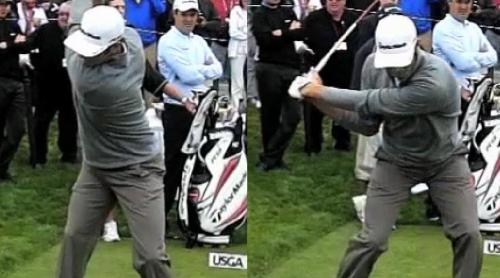
Lag Micro Move #7 – Right Shoulder Increase Retraction to Hit the Brakes
From the elevated view again, we can see DJ’s right scapula increase in retraction near the end of his backswing and into transition. Poor players are already hitting the gas with the right side and protracting the right shoulder early.
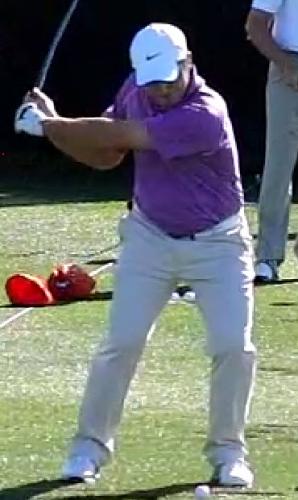
Here’s Francesco Molinari with a good looking position here.
Can you see he releases early? Why does this happen?
Lag Micro Move #8 – Right Scapula Dig (moves anteriorly and inferiorly) – More Brakes
I’ll start this animation to show the move from retraction to where the right scapula moves forward toward the front of the chest (what I once called scapula dig) and down (inferiorly). Since the arm goes from an elevated position to this, it is a bit of a circular movement of the scapula and arm.
Look for two micro moves. Watch for the creases in DJ’s right scapula area to disappear as the scapula is pulled forward. Also the creases in his right trapezius/clavicular area (between his neck and right shoulder) also disappear as the scapula rotates downward.
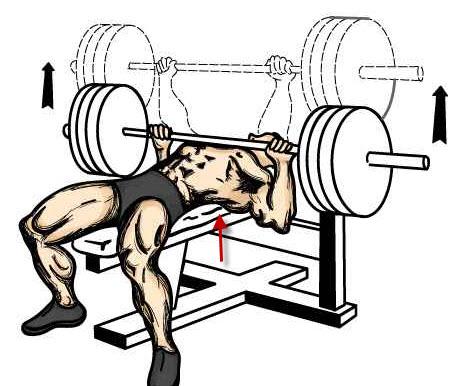
When the right scapula moves toward the front of the chest it is being pulled by your pectoral major or your chest muscles. Similar to when you are executing a bench press, your chest expands and your spine arches while your scapula is being pulled forward to the front of your chest as you prepare to push the bar up.
Note: The chest and the rhomboids are ultimately holding the right shoulder back (retraction) but in doing so it is also increasing the speed of spine rotation (and keeping the spine gears connected).
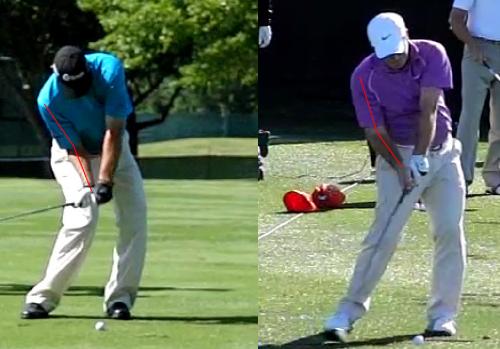
Thus spine rotation (via lateral bending and arching or lordosis) is what drives the right elbow forward! Then, since Molinari releases (relaxes) his lats and chest from doing their job, the natural occurrence is going to cause early right shoulder protraction (opposite of what you want) and then early movement to internally rotate the right shoulder which causes the early cast or loss of lag. The slight loss of lateral bend by Molinari is shown by his right shoulder appearing to be a bit higher than Gainey’s.
Try this yourself
If you arch your back and bend your spine to the right, see if you can put your right elbow forward like Gainey pictured below. Next, try removing the arch and bend. Can you still do it? You might be able to get your hands ahead but you can’t get your elbow to move forward anywhere near as far. In fact your hands will move ahead of your elbow (internal rotation). Thus, these moves are interconnected and you cannot possibly do this without the right spinal movements.
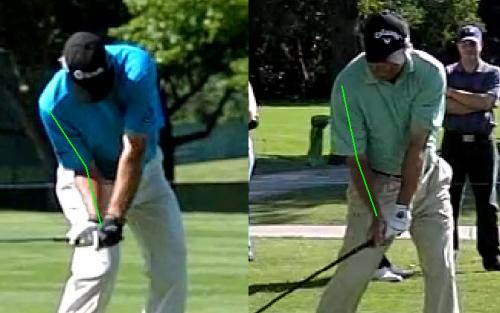
Compare Gainey with Olin Browne. Can you see that Olin’s right shoulder/arm has fired internally already and has run out of gas? Whereas Gainey has a lot more gas in the tank.
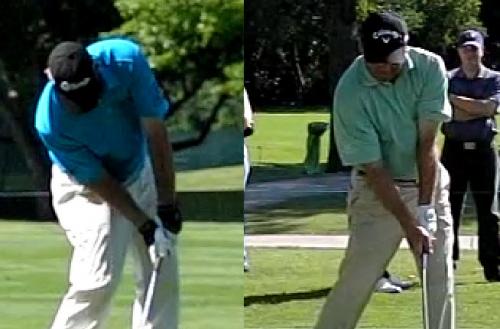
Perhaps this shows the anatomical sequencing. Once the right shoulder fires internally, it immediately straightens the right arm, and then pulls the right wrist into flexion. This is no different than Lincecum’s pitching arm motion. It follows the same sequence.
Firing the internal rotation of the right shoulder is an automatic trigger to fire the rest of the segments. The key is firing it as late as possible. Firing early will yield a flip.
Lag Micro Move #9 – Left Trapezius Contraction – More Gas
As I have mentioned in a previous article with Graeme McDowell as the model, the shoulders tilt coming into impact. While the right scapula digs to restrain the right shoulder from protracting and holds lateral bend, the left trapezius is responsible for raising the left shoulder while still pulling on the upper torso to rotate counterclockwise.
The left trapezius is located between his neck and shoulder. See the muscle bulge?
8 x .0033 = .026 or 26 milliseconds before impact.
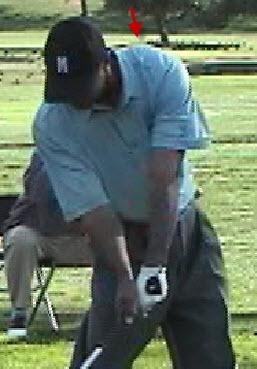
Tiger had this move as well.
Arm Lag
So what’s happening in the arms when all of this is happening in the shoulders? Just as there is clubhead lag where the club lags behind the hands/wrists, there is arm lag in which the arm lags behind the body. How does this happen?
In order to have arm lag, the spine and lower body area must be responsible for generating rotational power for the golf swing. If your body (spine) does not produce enough rotational power (due to excessive sliding), deliberate decelerating (for those that believe in the kinetic chain) or decides to take a coffee break after a short burst of work, your brain will trigger other muscle firings to instantaneously produce a swing that will use more shoulders/arms/wrists/hands. Then all of a sudden you have an early release, cast and flip because the power to swing the club has got to come from somewhere!!!
Take a second look at the differences in body rotation in Jamie vs. Brian. Can you see that Brian moves much more laterally, thus produces less rotation?
Could this explain the 125+ yard difference in their driving distance?
So how do we facilitate more body rotation?
Lag Micro Move #10 – Left Arm Pulls Against the Chest (Adduction)

The left arm is pulled against the chest thereby bringing the arms and club closer to the axis of rotation. This will lower the moment of inertia and allow you to build more speed. You can sort of see the left arm appear to be closer to the chest in the picture on the right.
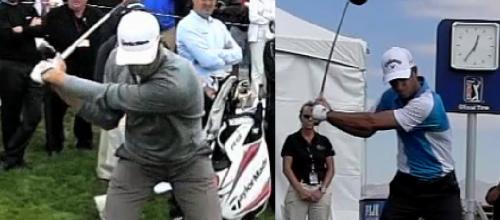
Can you see that DJ’s left arm is closer to his chest than James Nitties’?
From an elevated position, you can clearly see DJ’s left arm pulled into his chest (or remaining adducted). James’ left arm is already moving away from the chest (moving toward abduction) and so is the club. Shall we also say that he’s increasing his moment of inertia making it more difficult to rotate fast?
Lag Micro Move #11 – Right Hand/Elbow Pulls Left Arm into Chest
This move and the previous one are interconnected. They both work together to start to pull the arms and club closer to the body. They are both braking actions.
Here’s PGA tour driving distance leader JB Holmes with a tremendous elbow movements as well. His left arm appears to almost suspend itself at the top of the swing while the elbow drives down/forward with the right hand pulling back. This puts his right hand in position to hold or even increase the radial deviation (wrist cocking).
If the right hand were to step on the gas or push forward the left arm would move away from the chest and the stored energy would be lost in a millisecond.
Lag Micro Move #12 and #13– Right Forearm Pronation/Left Forearm Supination
This is a bit complicated because the arm is upside down at this point. There is a slight right forearm pronation and left forearm supination in transition as well. This two-move combo will combine to close the clubface while the external rotation of the right shoulder will tend to open the clubface.
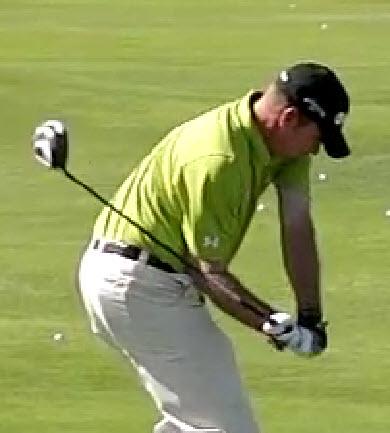
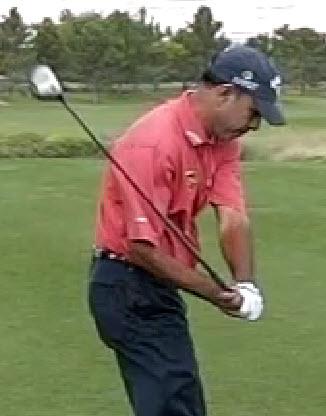
By the time the club is halfway down, this will make more sense. If the right forearm pronated (palm pointed down) and the left forearm supinated (palm pointed up) slightly, you’d look like Tommy Gainey. If not, you’d look more like Jeev Milkha Singh.
Pay close attention to the white lettering on Rickie’s grip. As he does all of these moves, the shaft rotates clockwise so that, by the end of the animation, the lettering has rotated clockwise to the bottom.
Here is a situation where the brakes are being applied to the forearms. The forearms want to pull forward in early left wrist extension/right wrist flexion as well as left wrist pronation/right wrist supination at this point. But this micro move will build stored energy in the forearms as well as keep the clubface from getting so open that it will require a flip or flip/roll of the wrists to square the clubface.
What You Should See
Actually a product of all of the moves, the elbows will appear to narrow when viewing from behind the target line. Also, the right elbow will appear below the left arm from front view.
Here’s Martin Kaymer showing this animation. If one does not have enough external rotation of the right shoulder, this will never happen. Or many golfers have their right shoulder fully externally rotated on the backswing and this will trigger an early internal rotation of the shoulder. This will cause the elbows to widen during the downswing.
Brian’s elbows are farther apart and his right shoulder is internally rotating to start the downswing.
Short, Long, Longest
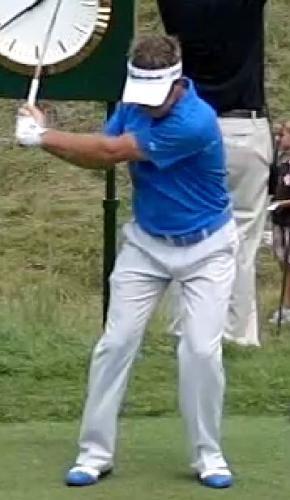
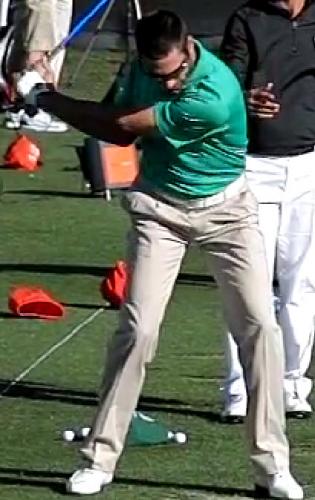
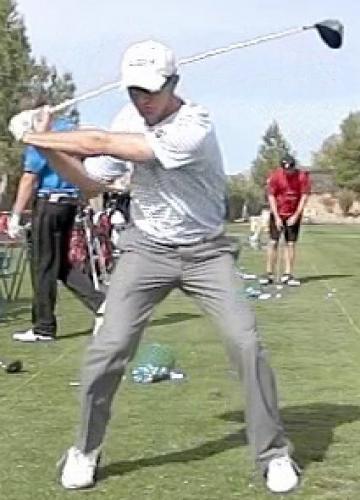
If you’ll just look at the body positions in relation to the shoulders and arms, JS has the most lower body rotation (plus he’s in a position dual ER/AB where he can continue to rotate fully) compared to Alvaro and then Brian.
Alvaro has very good lower body rotation but is not fully in dual ER and AB. Also his left arm is not as fully extended. Could this be why he’s at least 50-75 yards shorter than Jamie?
Brian has his legs/hips in a locked position (dual IR) and his left shoulder is beginning to retract thereby causing early loss of lag. Enough said.
Recap
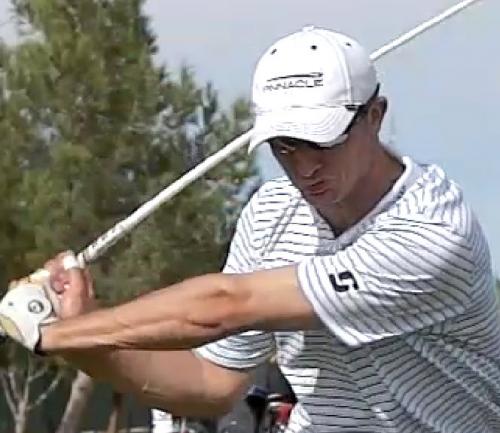
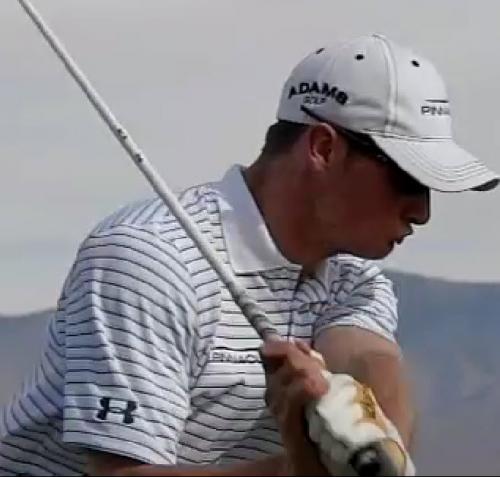
This is no optical illusion. The club and arms are close to his body.
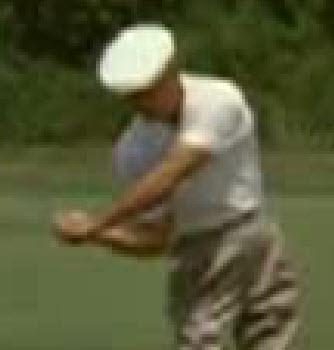
Isn’t this what Hogan was talking about?
Here are some cause and effects of in relation to lag.
- If the lag is lost or deliberately decreased early in the downswing, the rotational speed will be lower due to the mass of the club and arms being farther from the center of rotation (increasing moment of inertia). Try throwing a shot put like a baseball to see how fast or far you can throw with a large mass far from your rotational center.
- Body rotation or torque is required to maintain arm lag. If the body rotation slows down due to excessive sliding (linear movement is not rotational movement) or intentional/unintentional deceleration by the lower body, the arms will race past the slow moving body.
- Applying positive torque or hitting the gas with the shoulders/arms/hands too early is going to cause the loss of lag and therefore flip or worse an over the top downswing.
- Spinout of the hips is only going to occur when there is no connection from upper to lower halves of the body. These lag moves make up this connection. Also, spinning out implies that everything is firing toward the ball at the same time. All gas, no brakes.
Bottom Line
Virtually everything instinctive to hit the ball will lead to hitting the gas pedal only. While this may seem logical, this is why we have so many amateurs coming over the top or flipping at it. Thus, it will certainly help to understand that we need clubhead lag, arm lag and spine/body rotation to build your golf swing upon.
So training these muscles to hold lag is very important and I know it’s been awhile but I’m almost done with a combination lag trainer and impact resistance trainer that replaces how I was using the bodyblade. It’s far more specific than using the bodyblade while incorporating all the micro moves involved in the training of lag.
Next month I will cover the release of lag which is every bit as important as developing and retaining lag. There are some micro moves of the shoulders/arms/wrists/hands that are creating extra power in the late stages of the swing prior to contact and no, they don’t involve deceleration. There are active muscle contractions involved in the release that are being used by the best ballstrikers on the planet.

